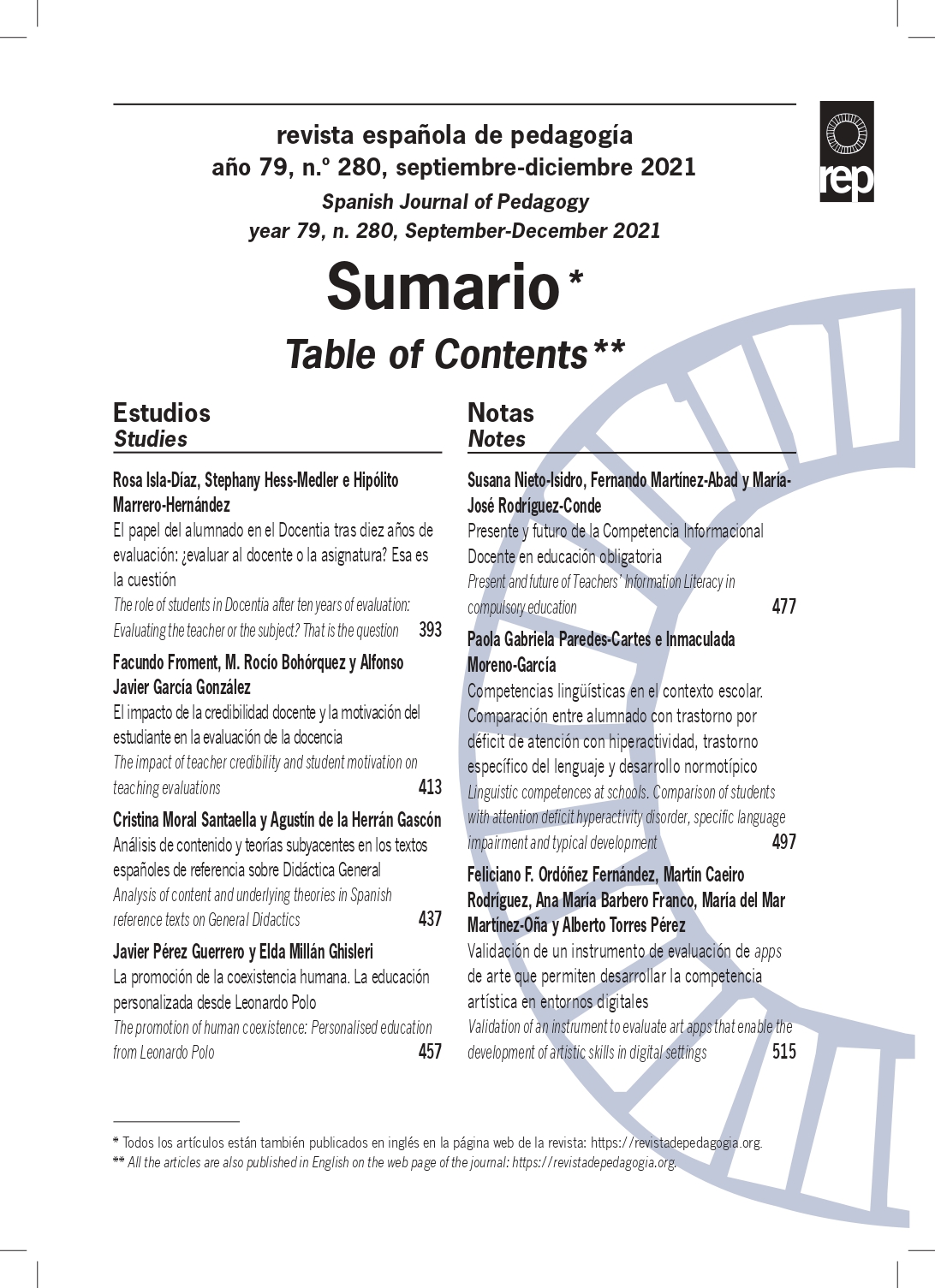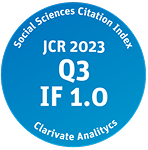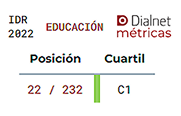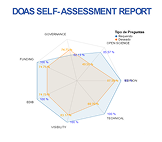Linguistic competences at schools. Comparison of students with attention deficit hyperactivity disorder, specific language impairment and typical development.
DOI:
https://doi.org/10.22550/REP79-3-2021-04Keywords:
ADHD, SLI, student, linguistic skills, pragmatics, semanticsAbstract
Research shows a high comorbidity between attention deficit hyperactivity disorder (ADHD) and language problems, similar to those seen in subjects with specific language impairment (SLI) (Helland et al., 2014; Korrel et al., 2017). Our goal was to assess the differences in semantic and pragmatic linguistic competences between students with ADHD versus SLI and children with typical development. A total of 142 students, ages 7-12 (M=9.27; SD=1.41), from public, subsidised and private schools participated in the study: 48 (33.80%) with ADHD, 47 (33.09%) with SLI, and 47 (33.09%) with normal development. Linguistic competences were evaluated using the Objective and Criterion-referenced Language Suite (Batería de Lenguaje Objetiva y Criterial, or BLOC, Puyuelo et al., 1997). We found significant differences in semantic (F (2.148)=86.99, p<.001) and pragmatic language skills (F (2.428)=83.00, p<.001) between the three study groups: ADHD, SLI and typical development. Students with ADHD present fewer deficits in aspects of semantic language than those with SLI. However, they face greater obstacles in certain uses of pragmatic language compared with the children with SLI and typically developed students. They face significant difficulties in the use of pragmatic language in different communication situations and social interaction, and in different functions and uses.
Downloads
References
Acosta, R., Ramírez-Santana, G. y Hernández, E. (2016). Las funciones ejecutivas y el lenguaje en niños con diferentes subtipos de trastorno específico del lenguaje. Neurología, 16, 213- 4853. https://doi.org/10.1016/j.nrl.2015.12.018
Acosta, V., Axpe, A. y Moreno, A. (2014). Rendimiento lingüístico y procesos lectores en alumnado con Trastorno Específico del Lenguaje. revista española de pedagogía, 72 (259), 477-490.
American Psychiatric Association (2013). Manual diagnóstico y estadístico de los trastornos mentales (DSM-5). Editorial Médica Panamericana.
Andreu, L., Sanz-Torrent, M., Guàrdia-Olmos, J. y MacWhinney, B. (2011). Narrative comprehension and production in children with SLI: An eye movement study [Comprensión y producción narrativa en niños con TEL: un estudio de movimientos oculares]. Clinical Linguistics and Phonetics, 25 (9), 767-783. https://doi.org/10.3109/02699206.2011.565542
Barkley, R. A. (2011). Niños hiperactivos. Cómo comprender y entender sus necesidades especiales. Guía completa del trastorno por déficit de atención con hiperactividad TDAH. Paidos.
Bellani, M., Moretti, A., Perlini, C. y Brambilla, P. (2011). Language disturbances in ADHD [Alteraciones del lenguaje en el TDAH]. Epidemiology and Psychiatric Sciences, 20 (4), 311-315. https://doi.org/10.1017/S2045796011000527
Brown, T. E. (2010). Comorbilidades del TDAH. Manual de las complicaciones del trastorno con déficit de atención con hiperactividad en niños y adultos. Editorial Elsevier Masson.
Buiza, J., Rodríguez-Parra, M. y Adrián, J. (2015). Trastorno Específico del Lenguaje: marcadores psicolingüísticos en semántica y pragmática en niños españoles. Anales de Psicología, 3 (1), 879-889. https://doi.org/10.6018/analesps.31.3.180091
Coady, A. (2013). Rapid naming by children with and without specific language impairment [Denominación rápida por parte de los niños con y sin discapacidades lingüísticas específicas]. Journal oof Speech, Language, Hearing Research, 56 (2), 604-617. https://doi.org/10.1044/1092-4388(2012/10-0144)
Conti-Ramsden, G., Bishop, M., Clark, B., Norbury, F. y Snowling, J. (2013). Toma de conciencia sobre los trastornos específicos del lenguaje: la campaña RALLI en Internet. Revista de Logopedia, Foniatría y Audiología, 33 (2), 51-54. https://doi.org/10.1016/j.rlfa.2013.04.004
Crespo-Eguílaz, N., Magallón, S., Sánchez-Carpintero, R. y Narbona, J. (2016). La adaptación al castellano de la Children’s Communication Checklist permite detectar las dificultades en el uso pragmático del lenguaje y diferenciar subtipos clínicos. Revista Neurología, 1, 49-57. https://doi.org/10.33588/rn.62S01.2015526
Dunn, L. M. y Dunn, L. M. (2006). Test de vocabulario en imágenes. Editorial TEA Ediciones.
Ercan, E., Unsel-BolaT, G., Tufab, A., Demirkaya, S., Bilac, O., Celik, G., Kilic, B., Ardic, U., Sapmaz, S., Aksu, H., Tahiroglu, A., Karacetin, G., Turak, U., Aktepe, E., Arman, A., Basgul, S., Coskum, M., Dursun, O., Durukan, I., Fis, N., … Gormez, V. (2021). Effect of impairment on the prevalence and comorbidities of attention deficit hyperactivity disorder in a national survey: Nation-wide prevalence and comorbidities of ADHD [Efecto de la deficiencia en la prevalencia y las comorbilidades del trastorno por déficit de atención con hiperactividad en una encuesta nacional: prevalencia y comorbilidades del TDAH a nivel nacional]. Journal of Attention Disorders. https://doi.org/10.1177/10870547211017985
Evans, J. L. y Coady, J. A. (2010). Explaining lexical-semantic deficits in specific language impairment: The role of phonological similarity, phonological working memory, and lexical competition [Explicación de los déficits léxico-semánticos en las deficiencias específicas del lenguaje: el papel de la similitud fonológica, la memoria de trabajo fonológica y la competencia léxica]. Journal of Speech, Language, and Hearing Research, 53 (6), 1742-1756. https://doi.org/10.1044/1092-4388(2010/08-0198)
Faraone, V. S., Banaschewski, T., Coghill, D., Zheng, Y., Biederman, J., Bellgrove, M. A., Newcorn, J. H., Gignac, M., Al Saud, N. M., Manor, I., Rohde, L. A., Yang, L., Cortese, S., Almagor, D., Stein, M. A., Albatti, T. H., Aljoudi, H. F., Alqahtani, M. M. J., Asherson, P., … Wang, Y. (2021). The World Federation of ADHD international consensus statement: 208 evidence-based conclusions about the disorder [Declaración de consenso internacional de la Federación Mundial de TDAH: 208 conclusiones basadas en la evidencia sobre el trastorno]. Neuroscience & Biobehavioral Reviews, 128, 789-818. https://doi.org/10.1016/j.neubiorev.2021.01.022
Flory, K., Milich, R., Lorch, E. P., Hayden, A. N., Strange, C. y Welsh, R. (2006). Online story comprehension among children with ADHD: Which core deficits are involved? [Comprensión de historias en línea entre niños con TDAH: ¿qué déficits básicos están implicados?] Journal of Abnormal Child Psychology, 34, 853-865. https://doi.org/10.1007/s10802-006-9070-7
Gallardo-Paúls, B., Gimeno-Martínez, M. y Moreno-Campos, V. (2010). Pragmática textual en adolescentes con trastorno por déficit de atención/hiperactividad: argumentación. Revista Neurología, 50, 113-7.
González-Castro, P., Rodríguez, C., Cueli, M., Cabeza, L. y Álvarez, L. (2013). Competencias matemáticas y control ejecutivo en estudiantes con trastorno por déficit de atención con hiperactividad y dificultades de aprendizaje de las matemáticas. Revista de Psicodidáctica, 19 (1), 125-143.
Helland, W. A ., Helland, T. y Heimann, M. (2014). Language profiles and mental health problems in children with specific language impairment and children with ADHD [Perfiles lingüísticos y problemas de salud mental en niños con deficiencias específicas del lenguaje y niños con TDAH]. Journal of Attention Disorders, 15 (3), 26-35. https://doi.org/10.1177/1087054712441705
Helland, W. A., Posserud, M. B., Helland, T., Heimann, M. y Lundervold, A. J. (2016). Language impairments in children with ADHD and in children with reading disorder [Alteraciones del lenguaje en niños con TDAH y en niños con trastorno de la lectura]. Journal of Attention Disorders, 20 (7), 581-589. https://doi.org/10.1177/1087054712461530
Hutchinson, E., Bavin, E., Efron, D. y Sciberras, E. (2012). A comparison of working memory profiles in school-aged children with specificl language impairment, attention deficit/hyperactivity disorder, comorbid SLI and ADHD and their typically developing peers [Una comparación de los perfiles de la memoria de trabajo en niños en edad escolar con deterioro específico del lenguaje, trastorno por déficit de atención/ hiperactividad, TEL comórbido y TDAH y sus compañeros con desarrollo típico]. Journal Neuropsychol Child, 18 (2), 190-207. https://doi.org/10.1080/09297049.2011.601288
Idiazábal, M., Guerrero, D. y Sánchez, M. (2006). Procesamiento del lenguaje en el trastorno por déficit de atención con hiperactividad. Revista de Neurología, 42 (2), 29-36. https://doi.org/10.33588/rn.42S02.2005783
Kaufman, A. y Kaufman, N. (2009). Test Breve de Inteligencia K-BIT. TEA Ediciones.
Korrel, H., Mueller, K. L., Seda, T., Anderson, V. y Sciberras, E. (2017). Research review: Language problems in children with attention-deficit hyperactivity disorder — a systematic meta-analytic review [Revisión de la investigación: lenguaje problemas de lenguaje en niños con trastorno por déficit de atención e hiperactividad — una revisión meta-analítica revisión analítica sistemática]. Journal Child Psychology Psychiatry, 10. https://doi.org/10.1111/jcpp.12688
Lambalgen, M., Kruistum, C. y Parigger, E. (2008). Procesamiento del discurso en el trastorno de déficit de atención e hiperactividad TDAH. Diario de la Lógica, Lenguaje e Información, 17 (4), 467-487. https://doi.org/10.1007/s10849-008-9066-5
McGrath, L., Pennington, B., Shanahan, M., Santerre-Lemmon, L., Barnard, H., Willcutt E., Defries, J. y Olson, R. ( 2011). A multiple deficit model of reading disability and attention deficit/hyperactivity disorder: the search for shared cognitive deficits [Un modelo de déficit múltiple de la discapacidad lectora y del trastorno por déficit de atención/hiperactividad: la búsqueda de déficits cognitivos compartidos]. The Journal of Child Psychology and Psychiatry, 52 (5), 547-57. https://doi.org/10.1111/j.1469-7610.2010.02346.x
McGregor, K., Rost, C., Guo, L. y Sheng, L. (2010). What compounds mean to children with SLI [Qué significan los compuestos para los niños con TEL]. Applied Psycholinguistics, 31 (3), 463-487. https://doi.org/10.1017/S014271641000007X
Mendoza, E. (2016). Trastorno específico del lenguaje (TEL). Avances en el estudio de un trastorno invisible. Ediciones Pirámide.
Moraleda, E., Fernández, L., Sánchez, J., López, P. (2018). Perfil lingüístico en niños y adolescentes con trastorno por déficit de atención e hiperactividad-TDAH. International Journal Developmental Educational Psycholy, 2, 151-158.
Mueller, L. y Tomblin, B. (2012). Examining the comorbidity of language disorders and ADHD [Examinar la comorbilidad de los trastornos del lenguaje y el TDAH]. Topics in Language Disorders, 32 (3), 228-46.
Noger, S. y Artiga, J. (2009). Trastorno de déficit de atención hiperactividad. En J. Artigas (Ed.), El niño incomprendido (pp. 35-55). Editorial Amat, S.L.
Peetsa, K. y Tannock, R. (2011). Los errores y autocorrecciones en la narración distinguen el TDAH del TDAH con trastornos del lenguaje. Revista de Logopedia, Foniatría y Audiología, 31 (4), 228-236. https://doi.org/10.1016/S0214-4603(11)70191-7
Puyuelo, M., Wiig, E. H., Renom, J. y Solanas, A. (1997). Batería del lenguaje objetiva y criterial. Editorial Masson.
Ramírez-Santana, G. M., Acosta-Rodríguez, V. M., Moreno-Santana, A. M., del Valle-Hernández, N. y Axpe-Caballero, Á. (2017). El uso combinado de narraciones orales y actividades morfosintácticas para mejorar habilidades gramaticales de alumnado con trastorno específico del lenguaje (TEL). Revista de Psicodidáctica, 23 (1), 48-55. https://doi.org/10.1016/j.psicod.2017.07.002
Rodríguez-Meirinhos, A. y Ciria-Barreiro, E. (2018). Revisión de intervenciones para mejorar las habilidades pragmáticas en niños y niñas con problemas de conducta y atención | Review of interventions to improve pragmatic language skills in children with behaviour and attention problems. revista española de pedagogía, 76 (270), 295-312. https://doi.org/10.22550/REP76-2-2018-05
Schreiber, J., Possin, K., Girard, J. y Rey-Casserly, C. (2014). Executive function in children with attention deficit hyperactivity: NIH EXAMINER battery [Función ejecutiva en niños con déficit de atención e hiperactividad: batería NIH EXAMINER]. Journal of the International Society of Neuropsychology, 20 (1), 41-51. https://doi.org/10.1017/S1355617713001100
Shaw, P., Malek, M., Watson, B., Sharp, W., Evans, A. y Greenstein, D. (2012). Development of cortical surface area and gyrification in attention-deficit/hyperactivity disorder [Desarrollo de la superficie cortical y giroscopia en el trastorno por déficit de atención/hiperactividad]. Biological Psychiatry, 72 (3), 191-197. https://doi.org/10.1016/j.biopsych.2012.01.031
Sowerby, P., Seal, S. y Tripp, G. (2011). Working memory deficits in ADHD: The contribution of age, learning/language difficulties, and task parameters [Déficits de la memoria de trabajo en el TDAH: la contribución de la edad, las dificultades de aprendizaje/lenguaje y los parámetros de la tarea]. Journal of Attention Disorders, 15, 461-472. https://doi.org/10.1177/1087054710370674
Staikova, E., Gomes, H., Tartter, V., McCabe, A. y Halperin, J. M. (2013). Deficits pragmáticos y el deterioro social en los niños con TDAH. Journal Child Psychol Psychiatry, 12, 1275-1283.
Szenkman, D., Fumagalli, J. y Martínez-Cuitiño, M. (2015). Adaptación de una herramienta para evaluar la morfosintaxis temprana. El Rice-Wexler Test of Early Grammatical Impairment TEGI [Presentación de póster]. VII Congreso Internacional de Investigación y Práctica Profesional en Psicología. XXII Jornadas de Investigación Décimo Encuentro de Investigadores en Psicología del MERCOSUR. Facultad de Psicología, Universidad de Buenos Aires, Buenos Aires. http://dx.doi.org/10.13140/RG.2.1.4753.8802
Tomblin, J. B. y Mueller, L. K. (2012). How can comorbidity with attention-deficit/hyperactivity disorder aid understanding of language and speech disorders? [¿Cómo puede la comorbilidad con el trastorno por déficit de atención/hiperactividad ayudar a comprender los trastornos del lenguaje y del habla?] Topics in Language Disorders, 32 (3), 198-206. http://dx.doi.org/10.1097/TLD.0b013e318261c264
Uekermann, J., Kraemer, M., Abdel-Hamid, M., Schimmelmann, B. G., Hebebrand, J., Daum, I., Wiltfang, J. y Kis, B. (2010). Social cognition in attention-deficit hyperactivity disorder (ADHD) [La cognición social en el trastorno por déficit de atención e hiperactividad (TDAH)]. Neuroscience and Biobehavioral Reviews, 34 (5), 734-743. https://doi.org/10.1016/j.neubiorev.2009.10.009
Vaughn, A., Epstein, J., Rausch, J., Altaye, J., Newcorn, J., Hinshaw, S. y Wigal, T. (2011). Relation between outcomes on a continuous performance test and ADHD symptoms over time [Relación entre los resultados de una prueba de rendimiento continuo y los síntomas del TDAH a lo largo del tiempo]. Journal of Abnormal Child Psychology, 39, 853-864. https://doi.org/10.1007/s10802-011-9501-y
Ygual, A. (2011). Los trastornos del lenguaje en el trastorno por déficit de atención con hiperactividad (TDAH). Revista de Logopedia, Foniatría y Audiología, 31 (4), 181-182. https://doi.org/10.1016/S0214-4603(11)70186-3
Zegarra-Valdivia1, J. y Chino, B. (2017). Mentalization and the theory of mind [Mentalización y la teoría de la mente]. Journal of Neuro-Psychiatry, 80 (3), 189-199. http://dx.doi.org/10.20453/rnp.v80i3.3156
Downloads
Published
-
Abstract96
-
PDF (Español)52
-
PDF52
How to Cite
Issue
Section
License

This work is licensed under a Creative Commons Attribution-NonCommercial 4.0 International License.

